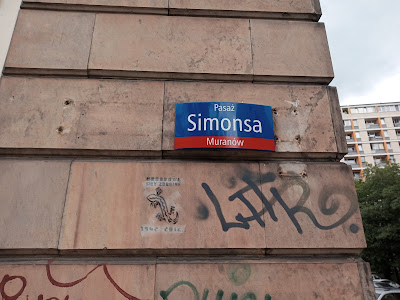Wojciech Zalewski, nazywany Wojtkiem ps. „Orzeł Biały”, „Wojtek” (ur. 1933, zm. 21 sierpnia 1944) to uczestnik powstania warszawskiego w szeregach Zgrupowania „Chrobry II”. Po wybuchu powstania warszawskiego w dniu 1 sierpnia 1944 wstąpił na ochotnika jako łącznik do III plutonu st. sierż. „Grzesia” – 5. kompanii – II batalionu „Lecha Grzybowskiego” – Zgrupowania „Chrobry II”. Był najmłodszym żołnierzem grupy szturmowej st. sierż. „Grzesia”. 2 sierpnia przedarł się przez linie niemieckie na teren silnie obsadzonego Dworca Głównego, skąd powrócił z meldunkiem o siłach, rodzaju uzbrojenia i ugrupowaniu wrogich oddziałów. 15 sierpnia 1944 wyprowadził znajdujący się w okrążeniu pluton st. sierż. „Grzesia”. Za tę ostatnią akcję miał zostać przedstawiony przez dowódcę batalionu do odznaczenia Krzyżem Walecznych, którym prawdopodobnie jednak nie został wyróżniony.
Zginął w trakcie przenoszenia meldunku w dniu 21 sierpnia 1944. Jego ciało spod ostrzału niemieckiego wyciągnęli towarzysze broni, co zostało utrwalone przez filmowców z ekipy Biura Informacji i Propagandy KG AK. Powstańczy pogrzeb Wojtka Zalewskiego odbył się na podwórzu domu przy ul. Ceglanej 3. Po wojnie nie udało się grobu odnaleźć i ekshumować jego ciała.
21 sierpnia 2019 w 75 rocznicę śmierci Wojtka Zalewskiego w miejscu, gdzie zginął w trakcie powstania warszawskiego, z inicjatywy Anny Szarejko, odsłonięto tablicę pamiątkową znajdującą się przy ul. Icchoka Lejba Pereca na warszawskiej Woli.

Wojciech Zalewski, Spitzname Wojtek ps. „Orzeł Biały“, „Wojtek“ (geboren 1933, gestorben am 21. August 1944) war Teilnehmer des Warschauer Aufstands in den Reihen der Gruppe „Chrobry II“. Nach Ausbruch des Warschauer Aufstands am 1. August 1944 meldete er sich freiwillig als Verbindungsmann zum 3. Zug Oberfeldwebel. "Grzesia" - 5. Kompanie - 2. Bataillon "Lech Grzybowski" - Gruppe "Chrobry II". Er war der jüngste Soldat des Oberfeldwebels der Angriffsgruppe. "Grzesia". Am 2. August durchbrach er die deutschen Linien zum stark besetzten Hauptbahnhof, von wo er mit einem Bericht über die Streitkräfte, Art der Bewaffnung und Gruppierung der feindlichen Truppen zurückkehrte. Am 15. August 1944 führte er den eingekreisten Zug von Sgt. "Grzesia". Für letztere Aktion sollte er vom Bataillonskommandeur mit dem Kreuz der Tapferkeit zur Auszeichnung überreicht werden, was ihm wohl nicht verliehen wurde.
Er starb bei der Übermittlung des Berichts am 21. August 1944. Seine Leiche wurde von seinen Mitstreitern aus dem deutschen Feuer gezogen, was von den Filmemachern des Informations- und Propagandabüros des Hauptquartiers der Heimatarmee aufgezeichnet wurde. Die aufständische Beerdigung von Wojtek Zalewski fand im Hof des Hauses in der ul. Ceglana 3. Nach dem Krieg konnte sein Grab nicht gefunden und seine Leiche exhumiert werden.
Am 21. August 2019, zum 75. Todestag von Wojtek Zalewski, wurde an dem Ort, an dem er während des Warschauer Aufstands starb, auf Initiative von Anna Szarejko eine Gedenktafel in der ul. Icchok Leib Peretz im Warschauer Stadtteil Wola.

Wojciech Zalewski, nicknamed Wojtek ps. "Orzeł Biały", "Wojtek" (born 1933, died 21 August 1944) was a participant in the Warsaw Uprising in the ranks of the "Chrobry II" Group. After the outbreak of the Warsaw Uprising on August 1, 1944, he volunteered as a liaison to the 3rd platoon of senior sergeant. "Grzesia" - 5th company - 2nd Battalion "Lech Grzybowski" - Group "Chrobry II". He was the youngest soldier of the assault group senior sergeant. "Grzesia". On August 2, he broke through the German lines to the heavily manned Main Railway Station, from where he returned with a report on the forces, type of armament and grouping of enemy troops. On August 15, 1944, he led out the encircled platoon of Sgt. "Grzesia". For the latter action, he was supposed to be presented by the battalion commander for decoration with the Cross of Valour, which he was probably not awarded with.
He died while carrying the report on August 21, 1944. His body was pulled out from the German fire by his comrades-in-arms, which was captured by filmmakers from the Information and Propaganda Bureau of the Home Army Headquarters. The insurgent funeral of Wojtek Zalewski took place in the yard of the house at ul. Ceglana 3. After the war, his grave could not be found and his body exhumed.
On August 21, 2019, on the 75th anniversary of Wojtek Zalewski's death, in the place where he died during the Warsaw Uprising, on the initiative of Anna Szarejko, a commemorative plaque was unveiled at ul. Icchok Leib Peretz in Warsaw's Wola district.













